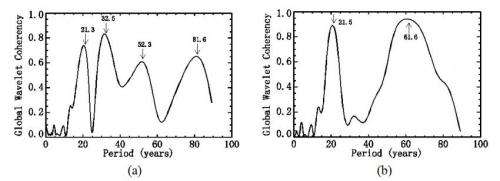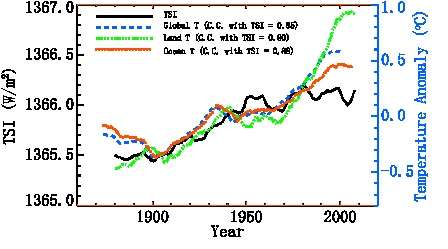Has solar activity influence on the Earth's global warming?

A recent study demonstrates the existence of significant resonance cycles and high correlations between solar activity and the Earth's averaged surface temperature during centuries. This provides a new clue to reveal the phenomenon of global warming in recent years.
Their work, entitled "Periodicities of solar activity and the surface temperature variation of the Earth and their correlations" was published in CHINESE SCIENCE BULLETIN (In Chinese) 2014 No.14 with the co-corresponding authors of Dr. Zhao Xinhua and Dr. Feng Xueshang from State key laboratory of space weather, CSSAR/NSSC, Chinese Academy of Sciences. It adopts the wavelet analysis technique and cross correlation method to investigate the periodicities of solar activity and the Earth's temperature as well as their correlations during the past centuries.
Global warming is one of the hottest and most debatable issues at present. The Intergovernmental Panel on Climate Change (IPCC) claimed that the release of the anthropogenic greenhouse gases contributed to 90% or even higher of the observed increase in the global average temperature in the past 50 years. However, the debate on the causes of the global warming never stops. Research shows that the current warming does not exceed the natural fluctuations of climate. The climate models of IPCC seem to underestimate the impact of natural factors on the climate change, while overstate that of human activities. Solar activity is an important ingredient of natural driving forces of climate. Therefore, it is valuable to investigate the influence of solar variability on the Earth's climate change on long time scales.
This innovative study combines the measured data with those reconstructed to disclose the periodicities of solar activity during centuries and their correlations with the Earth's temperature. The obtained results demonstrate that solar activity and the Earth's temperature have significant resonance cycles, and the Earth's temperature has periodic variations similar to those of solar activity (Figure 1).

This study also implies that the "modern maximum" of solar activity agrees well with the recent global warming of the Earth. A significant correlation between them can be found (Figure 2).
As pointed out by a peer reviewer, "this work provides a possible explanation for the global warming".
More information:
ZHAO X H, FENG X S. Periodicities of solar activity and the surface temperature variation of the Earth and their correlations (in Chinese). Chin Sci Bull (Chin Ver), 2014, 59: 1284, doi: 10.1360/972013-1089 csb.scichina.com:8080/kxtb/CN/ … abstract514043.shtml
Provided by Science China Press